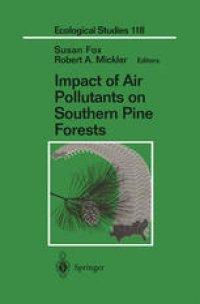
Ebook: Impact of Air Pollutants on Southern Pine Forests
- Tags: Ecology, Agriculture, Forestry
- Series: Ecological Studies 118
- Year: 1996
- Publisher: Springer-Verlag New York
- Edition: 1
- Language: English
- pdf
The public's attitude toward air pollution in the United States evolved substantially during the 1960s. One of the results of the nation's emerging environmental ethic was the creation of the U. S. Environmental Protection Agency (EPA) in December of 1970. Prior to this time, research was focused on the impacts of air pollution on human health and welfare and was largely conducted by several federal research agencies, which included the Department of Health, Education, and Welfare; the National Oceanic and Atmospheric Administration; and the U. S. Department of Agricul ture. After the creation of the EPA, much of this work was consolidated in one regulatory agency, which resulted in periodic evaluations of the various effects of atmospheric pollution on human health, materials, agriculture, and forest ecosystems. At the same time that environmental interest was growing in the United States, concern increased in the European scientific community and public over the ecological impacts of acidic deposition. As the magnitude of the damage to European lakes and streams and the widespread decline in Norway spruce and silver fir was reported, concern that similar problems were occurring in the United States increased substantially. This concern was heightened by press reports of high elevation spruce-fir forest declines in the Adirondack and Appalachian Mountains and the decline and death of sugar maples in the northeastern United States and Canada.
This book summarizes a five-year research program on the impact of air pollution on southern commercial forests. Topics covered include: the condition of southern commercial forests, abiotic and biotic stress factors on southern pine forests, growth and physiological effects of regional air pollutants on southern pines, and impacts of atmospheric deposition and ozone on southern commercial pines. The book will be of interest to scientists working on the effects of air pollution on trees, as well as environmentalists, policymakers, and resource managers.
This book summarizes a five-year research program on the impact of air pollution on southern commercial forests. Topics covered include: the condition of southern commercial forests, abiotic and biotic stress factors on southern pine forests, growth and physiological effects of regional air pollutants on southern pines, and impacts of atmospheric deposition and ozone on southern commercial pines. The book will be of interest to scientists working on the effects of air pollution on trees, as well as environmentalists, policymakers, and resource managers.
Content:
Front Matter....Pages i-xv
Front Matter....Pages 1-1
Introduction: The Southern Commercial Forest Research Cooperative....Pages 1-15
Front Matter....Pages 17-17
Southern Pine Forests of North America....Pages 19-57
Soils, Geomorphology, and Land Use of the Southeastern United States....Pages 58-82
Air Quality and Atmospheric Deposition in Southern U.S. Forests....Pages 83-170
Front Matter....Pages 171-171
Response of Loblolly Pine to Moisture and Nutrient Stress....Pages 173-195
An Overview of Responses of Southern Pines to Airborne Chemical Stresses....Pages 196-243
Biotic Agents of Stress in the South....Pages 244-280
Interactive Effects of Air Pollutants with Abiotic and Biotic Factors on Southern Pine Forests....Pages 281-312
Front Matter....Pages 313-313
Atmospheric Deposition and Soil Resources of the Southern Pine Forest....Pages 315-336
Atmospheric Nitrogen Deposition and the Mycorrhizae of Southern Commercial Forest Trees....Pages 337-387
Growth Response of Southern Pines to Acidic Precipitation and Ozone....Pages 388-424
Physiological and Biochemical Effects of Air Pollutants on Southern Pines....Pages 425-463
Front Matter....Pages 465-465
Synthesis and Conclusions from Studies of Southern Commercial Pines....Pages 467-490
Back Matter....Pages 491-516
This book summarizes a five-year research program on the impact of air pollution on southern commercial forests. Topics covered include: the condition of southern commercial forests, abiotic and biotic stress factors on southern pine forests, growth and physiological effects of regional air pollutants on southern pines, and impacts of atmospheric deposition and ozone on southern commercial pines. The book will be of interest to scientists working on the effects of air pollution on trees, as well as environmentalists, policymakers, and resource managers.
Content:
Front Matter....Pages i-xv
Front Matter....Pages 1-1
Introduction: The Southern Commercial Forest Research Cooperative....Pages 1-15
Front Matter....Pages 17-17
Southern Pine Forests of North America....Pages 19-57
Soils, Geomorphology, and Land Use of the Southeastern United States....Pages 58-82
Air Quality and Atmospheric Deposition in Southern U.S. Forests....Pages 83-170
Front Matter....Pages 171-171
Response of Loblolly Pine to Moisture and Nutrient Stress....Pages 173-195
An Overview of Responses of Southern Pines to Airborne Chemical Stresses....Pages 196-243
Biotic Agents of Stress in the South....Pages 244-280
Interactive Effects of Air Pollutants with Abiotic and Biotic Factors on Southern Pine Forests....Pages 281-312
Front Matter....Pages 313-313
Atmospheric Deposition and Soil Resources of the Southern Pine Forest....Pages 315-336
Atmospheric Nitrogen Deposition and the Mycorrhizae of Southern Commercial Forest Trees....Pages 337-387
Growth Response of Southern Pines to Acidic Precipitation and Ozone....Pages 388-424
Physiological and Biochemical Effects of Air Pollutants on Southern Pines....Pages 425-463
Front Matter....Pages 465-465
Synthesis and Conclusions from Studies of Southern Commercial Pines....Pages 467-490
Back Matter....Pages 491-516
....